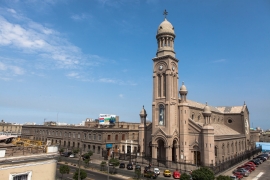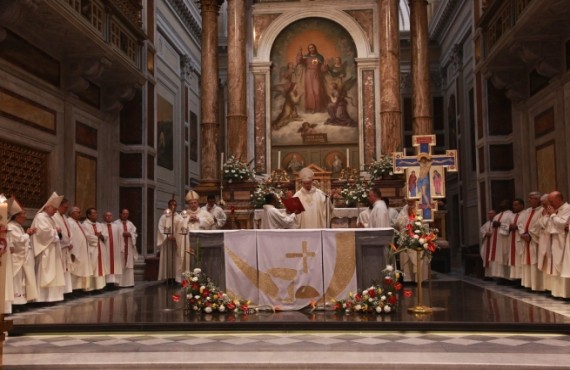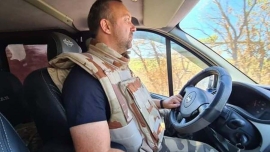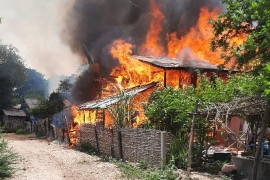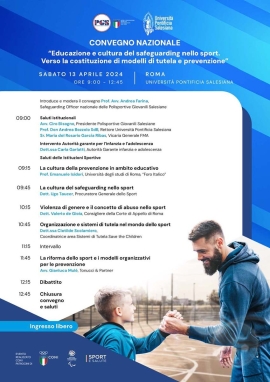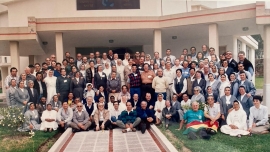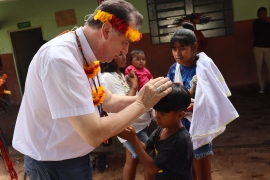Su arquitecto fue el sacerdote salesiano Ernesto Vespignani, quien la diseñó de estilo románico-bizantino, una variante del eclecticismo de evocación medieval. Posee tres naves que, junto al presbiterio, cubren un área de 2000 metros cuadrados, midiendo 70 metros de largo por 30 de ancho. Su fachada está dominada por la torre mayor de 56 metros de altura, escoltada por otras cuatro de menores dimensiones. Tiene tres puertas de acceso en el frontis (la central está protegida por un pórtico cuadrilátero sobre el que se eleva la torre mayor) además de cuatro ingresos laterales.
Debajo de la Basílica se construyó una Cripta, que abarca el espacio debajo del presbiterio. Mide un total de 500 metros cuadrados y estuvo conectada con la Basílica por una escalera que descendía desde su nave central. Posteriores modificaciones clausuraron este ingreso, reemplazándolo por accesos laterales que se utilizan hasta hoy.
Fue bendecida el 29 de julio de 1921 e inaugurada al día siguiente como Homenaje Nacional por el Centenario de la Independencia del Perú, con presencia del Presidente de la República Augusto B. Leguía y las principales autoridades políticas y eclesiásticas del país. Las obras pudieron ejecutarse gracias al impulso del padre Carlos Pane, quien asumió la difícil labor de recaudar los fondos para su construcción.
A lo largo de los años siguientes, la Basílica de María Auxiliadora fue ornamentada con piezas notables de arte religioso europeo y nacional. En pintura, destacan los catorce lienzos de los Misterios del Rosario (Giuseppe Cassioli, Florencia, 1934-1936). En escultura, la imagen de María Auxiliadora, originalmente ubicada en el altar mayor y hoy imagen procesional de los 24 de mayo (Talleres Salesianos de Sarriá, Barcelona, 1921), la actual imagen que preside el altar mayor (Vittorio Ferraro, Turín, 1937) y la gran estatua de la Virgen ubicada en el frontis (Natalicio Delgado, Lima, 1945). Y en vitrales, las seis series alusivas a las Obras de Misericordia Corporales, las Obras de Misericordia Espirituales, los Santos de la Iglesia, Santos Salesianos, Santos Peruanos y los Evangelistas (Tiroler Glasmalerei und Mosaik Anstalt, Insbruk, 1934).
Otros elementos destacados son la cruz de bronce de cuatro brazos que corona la torre (Escuela Nacional de Artes y Oficios, Lima, 1924); el reloj de cuatro discos (Alemania, 1924); las cinco primeras campanas (Ditta Fratelli Barigozzi, Milán, 1925); el pavimento de mármol (Sergio Vatteroni, Florencia, 1928); el órgano eléctrico de tubos (Giovanni Tamburini, Crema, 1934); el baldaquino con el segundo altar mayor (Federico Bonetti, Pietrasanta, 1934); las puertas de bronce, primero las centrales (Casa Negri, Lima, 1955) y luego las laterales (Ídem, 1959). También es necesario mencionar a los altares laterales de mármol, principalmente los dedicados al Señor de los Milagros (Casa Luisi, Pietrasanta, 1938), el Sagrado Corazón de Jesús (Casa Luisi, Pietrasanta, 1949) y Santa María Mazzarello (Casa Luisi, Pietrasanta, 1955).
Uno de los eventos más recordados en la historia del templo es el ocurrido el 24 de mayo de 1940. Se celebraba la misa pontifical de la Fiesta de María Auxiliadora, presidida por el Nuncio Apostólico, monseñor Fernando Cento, cuando desató un terremoto, el de mayor magnitud que azotó Lima en todo el siglo XX. A pesar que el templo era el lugar con mayor aglomeración de personas en toda la ciudad, y el pánico generado por las rajaduras de las bóvedas, no se registraron víctimas ni heridos entre los feligreses que se encontraban en la misa. Al año siguiente el Cabildo Eclesiástico de Lima reconoció este hecho como un signo evidente de la protección de María Auxiliadora sobre sus fieles.
La imponente riqueza ornamental de este templo y la milagrosa protección experimentada, motivó que Su Santidad el Papa Juan XXIII le otorgara el título de Basílica Menor el 25 de marzo de 1962, mediante las Letras Apostólicas “In Peculiare Decus”.
Al cumplirse medio siglo de esta designación, y ante la proximidad de la celebración del Bicentenario del Nacimiento de Don Bosco y del centenario de este templo, se llevaron a cabo entre 2011 y 2016 trabajos para su reforzamiento estructural y restauración artística. La participación masiva de los miembros de la Familia Salesiana del Perú en apoyo a estos trabajos evidenció el rol protagónico que la Basílica de María Auxiliadora ha tenido y sigue teniendo entre los hijos de Don Bosco en la patria de Santa Rosa de Lima.
DATOS
Nombre del Santuario Basílica de María Auxiliadora de Lima
Año de Construcción 1916-1924
Año de la Bendición 1921 (29 de julio): Centenario de la Independencia del Perú
Párroco o Responsable del Santuario R.P. Santo Dal Ben Lava
Personajes memorables que fueron responsables del Santuario:
Padre Ernesto Vespignani, el arquitecto salesiano más importante de la primera mitad del siglo XX. Autor del diseño de este templo en 1916.
Beato José Calasanz: Siendo Inspector del Perú y Bolivia bendijo el altar mayor de la Cripta en 1924.
Venerable Monseñor Octavio Ortiz Arrieta: Siendo Obispo de Chachapoyas consagró la Basílica en 1941.
Rectores Mayores Renato Ziggiotti, Luis Ricceri, Edigio Viganó, Pascual Chávez y Ángel Fernandez presidieron celebraciones eucarísticas en este templo entre 1960 y 2017.
Situaciones vividas: milagros u otras situaciones. Terremoto del 24 de mayo de 1940 (ver reseña).
-
 Title
Title
Title
Title
-
 Title
Title
Title
Title
-
 Title
Title
Title
Title
-
 Title
Title
Title
Title
-
 Title
Title
Title
Title
-
 Title
Title
Title
Title
-
 Title
Title
Title
Title
-
 Title
Title
Title
Title
-
 Title
Title
Title
Title
-
 Title
Title
Title
Title
https://www.infoans.org/en/item/5327-maria-ausiliatrice#sigProId4a35d763e3














